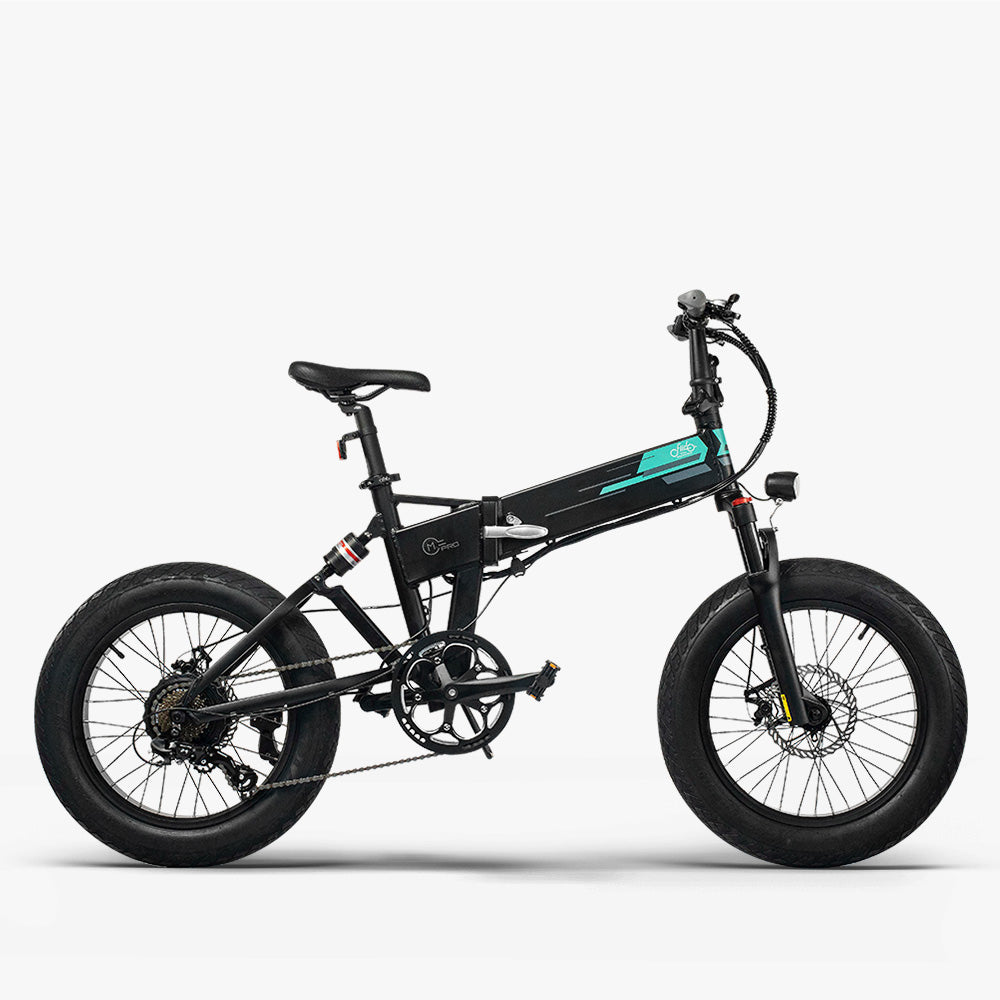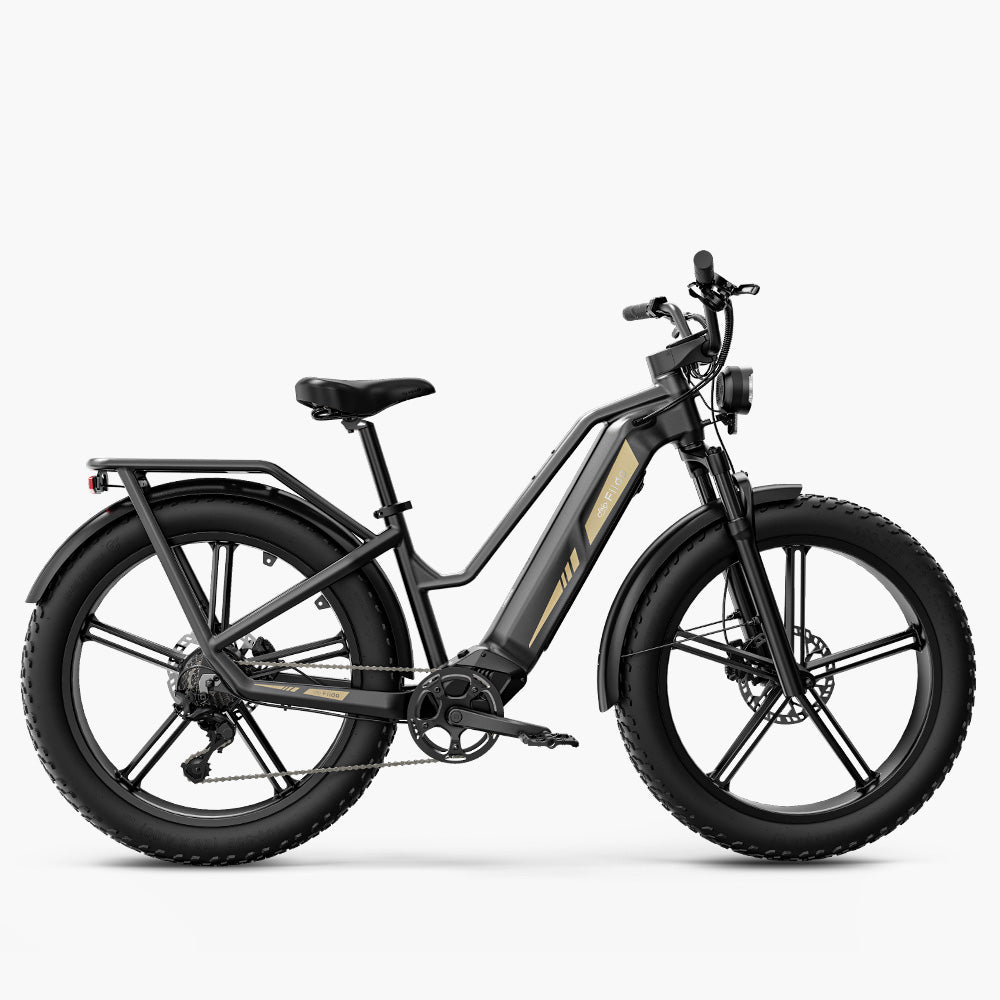When you're riding an electric bike, there's a fine line between thrill and danger—especially when you're riding at high speeds or need to make a sudden stop. One of the most unsettling risks you may encounter is rear wheel skidding. It can happen in a flash, leaving you struggling to regain control. So, how can you prevent it? In this article, we'll break down what causes rear wheel skidding, how to react when it happens, and the steps you can take to avoid it altogether, all while ensuring a safe and smooth ride.

Causes of Rear Wheel Skidding
- Abrupt Braking: When riders apply the brakes too suddenly at high speeds, especially with the rear brake, it can cause the rear wheel to lock up and skid. Electric bikes, with their powerful motors and higher speeds, are particularly susceptible to this.
- Low Friction on the Road: Slippery road conditions, such as wet roads, gravel, or icy surfaces, reduce the friction between the tires and the ground, making it easier for the rear wheel to lose traction and skid during emergency braking.
- Tire Issues: Worn-out tires or improper tire pressure can greatly reduce the traction of your bike, increasing the likelihood of a skid. If the tires are not properly maintained, their ability to grip the road is compromised.
- Overloading or Improper Cargo: Carrying too much weight on the bike, especially when riding at high speeds, can place excessive load on the rear wheel, increasing the risk of skidding.
What to Do When Your Rear Wheel Skids During High-Speed Braking
- Stay Calm, Avoid Panic
- The most important thing to do when your rear wheel starts to skid is to remain calm. Panicking may lead to incorrect reactions and make the situation worse. A composed mind and clear thinking are key to regaining control.
- Gradually Release the Brake, Reduce Braking Force
- If you feel the rear wheel starting to skid, do not keep pressing the brake forcefully. Instead, gently release the brake to allow the tire to regain traction. Braking too hard can cause the rear wheel to lock, worsening the skid. By releasing the brake slightly, you give the tire a chance to regain grip, which helps you regain control.
- Avoid Sudden Turns
- If the rear wheel starts to skid, avoid turning the handlebars or changing direction suddenly, as this can cause you to lose further control. Keep the handlebars steady and do not make abrupt steering movements, which reduces the risk of losing control.
- Apply Brakes Gradually
- When braking, especially at high speeds, avoid applying all of the braking force at once. Gradually increase the brake pressure to prevent the rear wheel from losing traction due to sudden braking. Smooth and progressive braking helps reduce the likelihood of skidding.
- Use Both Front and Rear Brakes Together
- When braking, try to use both the front and rear brakes in combination, rather than relying solely on the rear brake. The front brake provides more braking force but is more stable, helping you slow down efficiently while reducing the risk of rear wheel skidding. Make sure the braking force is balanced between the front and rear brakes to avoid excessive force on either side.
- Slow Down and Adapt to Road Conditions
- If you’re riding on a slippery or uneven surface (such as mud, gravel, or sand), reduce your speed in advance to avoid abrupt braking. High speed on such surfaces makes it easier for the tires to lose grip, increasing the chances of a skid.

Measures to Prevent Rear Wheel Skidding During High-Speed Braking
Preventing rear wheel skidding is not only about responding effectively when it happens, but also about taking proactive measures to reduce the likelihood of it occurring in the first place. Here are several steps you can take to prevent rear wheel skidding, especially when braking at high speeds:
Regularly inspect and maintain your tires
One of the most crucial steps to prevent skidding is ensuring your tires are in optimal condition. Regularly check your tire tread for wear and ensure they are properly inflated to the manufacturer’s recommended pressure. Low tire pressure reduces traction, increasing the risk of skidding, while worn tires have less grip on the road, making it harder to regain control during an emergency stop.
Pro Tip: If your tires are showing signs of wear, it’s time to replace them with new ones that provide better grip, especially if you're riding on rough or slippery terrains.
Master smooth and progressive braking techniques
Using proper braking techniques is key to maintaining control of your bike, especially when traveling at high speeds. Sudden, forceful braking is one of the main causes of rear wheel skidding. Instead of slamming on the brakes, apply them gently and progressively. Gradually increase brake pressure to decelerate smoothly without overwhelming the rear wheel, especially when the surface is slippery or uneven.
Pro Tip: Practice progressive braking in a safe, controlled environment to build muscle memory, so you can apply the technique instinctively when needed.
Use both brakes (front and rear) together
Relying solely on the rear brake to stop your bike can cause an imbalance, increasing the risk of skidding. A common mistake among riders is overusing the rear brake, as it’s often considered less powerful than the front brake. However, using both brakes together allows for more balanced braking and improves control. The front brake offers more stopping power, while the rear brake helps fine-tune the deceleration process.
Pro Tip: Practice using both brakes simultaneously, distributing the braking force between the front and rear to ensure smooth and controlled stops.
Adjust your speed according to road conditions
Braking at high speeds is always riskier when road conditions are unfavorable. Wet, icy, or uneven roads reduce tire traction and make skidding more likely. On these surfaces, it’s essential to reduce your speed well in advance of any stops or turns. Slowing down allows you to apply the brakes more effectively without risking a rear wheel skid.
Pro Tip: In winter or rainy conditions, try to keep your speed lower and maintain a greater distance between yourself and other riders or vehicles, giving yourself extra time to stop safely.
Avoid sudden or sharp turns while braking
When you're attempting to stop at high speeds, sharp turns or sudden handlebar movements can increase the risk of losing control. During a rear wheel skid, turning sharply can make things worse by unbalancing the bike and exacerbating the loss of traction. Keep your handlebars steady and avoid sudden steering inputs to maintain stability.
Pro Tip: Keep your body aligned with the bike and steer smoothly to avoid upsetting the bike's balance when coming to a stop.
Choose the right electric bike for off-road and high-speed conditions
The type of electric bike you ride plays a significant role in how well it handles high-speed braking. Bikes designed for off-road riding, like the Fiido Titan or the Fiido M1 Pro, are built with wide, anti-slip fat tires that provide superior grip, especially on rough or slippery surfaces. These tires increase stability, reduce the likelihood of rear wheel skidding, and make emergency braking much safer.
Pro Tip: If you're regularly riding on rough terrain, choose an electric bike with fat tires and a sturdy braking system that’s designed for challenging conditions.
Avoid overloading your bike
Excessive weight on your bike can strain the rear wheel and impact braking efficiency. Overloading not only increases the likelihood of skidding but also compromises your control over the bike, especially on inclines or uneven surfaces. Make sure your bike’s load capacity is within the recommended limits and avoid carrying bulky or heavy cargo that could destabilize the ride.
Pro Tip: If you need to carry extra weight, distribute it evenly across the bike, ensuring the load is centered and doesn’t affect the balance or braking performance.
Practice defensive riding and anticipate stops
Defensive riding involves anticipating potential hazards and adjusting your speed and braking accordingly. Always be aware of the road ahead, and anticipate obstacles or changes in the terrain that may require sudden braking. By recognizing potential risks early, you can adjust your speed and braking technique to avoid skidding altogether.
Pro Tip: Look ahead and keep a safe distance from other riders or vehicles, giving you more time to react if something unexpected happens.
By consistently applying these preventive measures and learning to react correctly when skidding occurs, you can significantly reduce the chances of rear wheel skidding and enjoy a smoother, safer ride on your electric bike.
Recommended Anti-Skid Electric Bikes: Fiido M1 Pro and Fiido Titan
If you're riding in challenging terrain, choosing a bike that provides excellent traction and stability is crucial. The Fiido M1 Pro and Fiido Titan are both designed for off-road conditions and come with wide, anti-slip fat tires that offer superior grip, ensuring greater stability and reducing the chances of rear wheel skidding.
- Fiido M1 Pro: This Fiido M1 pro fat tire electric bike features a powerful motor and a high-performance braking system, making it perfect for off-road riding. The wide fat tires provide excellent traction and enhance safety by reducing the likelihood of skidding
Fiido M1 Pro Fat Tire Electric Bike
The most cost-effective fat tire ebike for off-road adventures.
- Fiido Titan: Another off-road electric bike, the Fiido Titan off-road electric bike comes with a sturdy frame and a powerful motor system, making it ideal for more demanding terrains. Its anti-slip tires also provide better braking control, helping prevent rear wheel skidding.
Fiido Titan Robust Cargo Electric Bike
A powerhouse with a 248-mile range and 4-piston brakes, ideal for hunting and fishing trips.
Safety Riding Tips
Regardless of which electric bike you're riding, maintaining safety awareness is key. Here are some essential safety tips:
- Wear Proper Riding Gear: Always wear appropriate safety gear, such as a helmet, knee pads, and elbow pads, to minimize the risk of injury in case of a fall or skid.
- Avoid Riding at Night: Riding in low visibility conditions, especially at night, requires adequate lighting on your bike to ensure you can see and be seen by others.
- Watch for Weather Changes: Avoid riding at high speeds in rainy, snowy, or icy weather, as these conditions significantly reduce road traction.
- Maintain Your Bike’s Condition: Regularly check the brakes, tires, and lights to ensure your electric bike is in good working order. If any parts are worn or damaged, replace them promptly.
- Choose the Right Bike for Slippery Conditions: Select a bike suited to your specific needs and the terrain you'll be riding on. For slippery conditions, such as wet, icy, or muddy roads, consider a fat-tire bike like the Fiido M1 Pro or Fiido Titan for better stability and traction.
In conclusion, preventing rear wheel skidding during high-speed braking relies on selecting the right electric bike, mastering proper braking techniques, and taking preventive measures. The Fiido M1 Pro and Fiido Titan are ideal choices as off-road electric bikes, offering excellent grip and stability for safer and more enjoyable riding.















